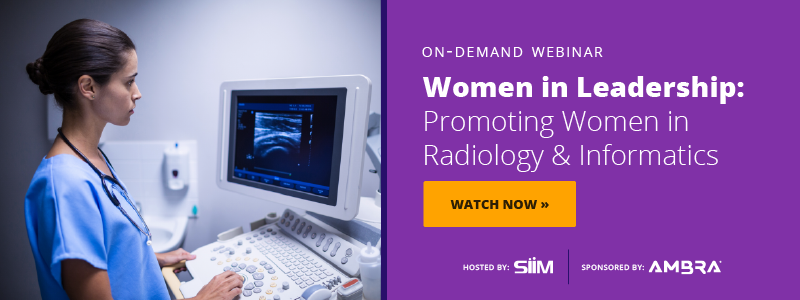This article by Ambra Health Senior Marketing Manager, Catherine Slotnick, was originally published on MedTech Boston on August 12, 2019.
If you’ve ever been to a meeting or conference in healthcare, there may be something that you have noticed: the lack of female speakers. And if you haven’t noticed before, I guarantee you will once you start paying attention.
Some have even coined this trend the “manel” — or the all-male panel.
Healthcare isn’t the only industry with this dilemma; a quick Google search will yield plenty of results across IT, engineering, computer science, academia, and more. In fact, there are even some blogs and Tumblr accounts that make fun of this very topic.
However, it’s no laughing matter, especially when it comes to healthcare. Geraldine McGinty M.D., MBA, FACR, Chief Strategy, and Contracting Officer, Weill Cornell Medicine Physician Organization and current Chair of the Board of Chancellors for the American College of Radiology, has been an outspoken voice in this space.
“Diverse representation in radiology is critical to effectively addressing the needs of our diverse patient population. Organizations should be thoughtful about this as they craft their agendas and panels,” said McGinty.
It is well documented that more diverse voices at the table produce better outcomes. According to a Forbes study of 321 executives in companies that grossed $500 million or more annually, one of the key findings was that, “diversity is a key driver of innovation and is a critical component of being successful on a global scale.”
McGinty is a founder and member of the steering committee of RADxx, a movement that fosters networking and mentorship opportunities for leaders in radiology and informatics. Recently, RADxx launched a speakers bureau featuring talented female speakers in the space. Today, the bureau has over 20 women including industry experts like Nicole Saphier, M.D., Director of Breast Imaging, MSK Monmouth and frequent health industry commentator; Carol Wu, M.D., Associate Professor, Department of Diagnostic Radiology, The University of Texas MD Anderson Cancer Center; and Olga R. Brook, M.D., Associate Professor at Harvard Medical School, Boston, M.A., and Clinical Director of CT at Beth Israel Deaconess Medical Center, Boston.
One study, Trends in the Proportion of Female Speakers at Medical Conferences in the United States and in Canada, 2007 to 2017, highlights that while the number of female speakers is on the rise, only about one-third of all speakers at medical conferences today are women.
The goal of the new RADxx speakers bureau, curated and vetted by the committee, is to promote more diversity in meeting and conference agendas.
“When I ask why there aren’t any women on a panel, I frequently get the same response; we didn’t know who to ask,” says Amy Kotsenas, M.D., RADxx steering committee member and Neuroradiologist & Clinical Informaticist at the Mayo Clinic. The RADxx speakers bureau provides a list of highly qualified women who are willing and eager to speak on panels, webinars, and more.
But as Kotsenas actively seeks out women to speak, she sometimes meets resistance.
“I find women to be highly critical of themselves. Even the most qualified candidate is nervous that she isn’t good enough. Comparatively, men are usually more confident in their abilities to speak on a topic even when it was one that they are not experts,” said Kotsenas.
She noted that many women (including herself as a recovering patient!) suffer from imposter syndrome, or a feeling of inadequacy despite being highly qualified. The best solution for imposter syndrome? Encouragement and opportunity. Organizations like RADxx work to sponsor and mentor other women and encourage them to join industries like radiology and informatics where female membership is still low. With only 21% of practicing radiologists today being female, the specialty can sometimes seem like a “boys’ club.”
Optics are important here; medical school residents often site dedicated exposure as a key reason for selecting a specialty during medical school. Many are looking for a mentor, but a mentor and sponsor, although the terms are often used interchangeably, are two very different yet necessary individuals needed in one’s career. Members of the RADxx steering committee have defined a mentor as someone who offers help and advice, but a sponsor is someone who guides you in the steps to advance your career, including advocating for you in the workspace.
Nina Kottler, RADxx steering committee member and VP of Clinical Operations at Radiology Partners, shared on a live webinar event that as someone who has both mentored and sponsored in her career, she finds it highly impactful to share mistakes and get rid of the illusion that successful people never experienced any bumps along the way. Perhaps, if we encourage women that they aren’t an imposter but rather, a highly qualified individual, they will feel more confident in their abilities to take part in conference agendas.
And for those women who have already achieved those goals, it is important to reflect back on who sponsored them along the way and consider offering the same hand to younger women in the field.




 The
The 

